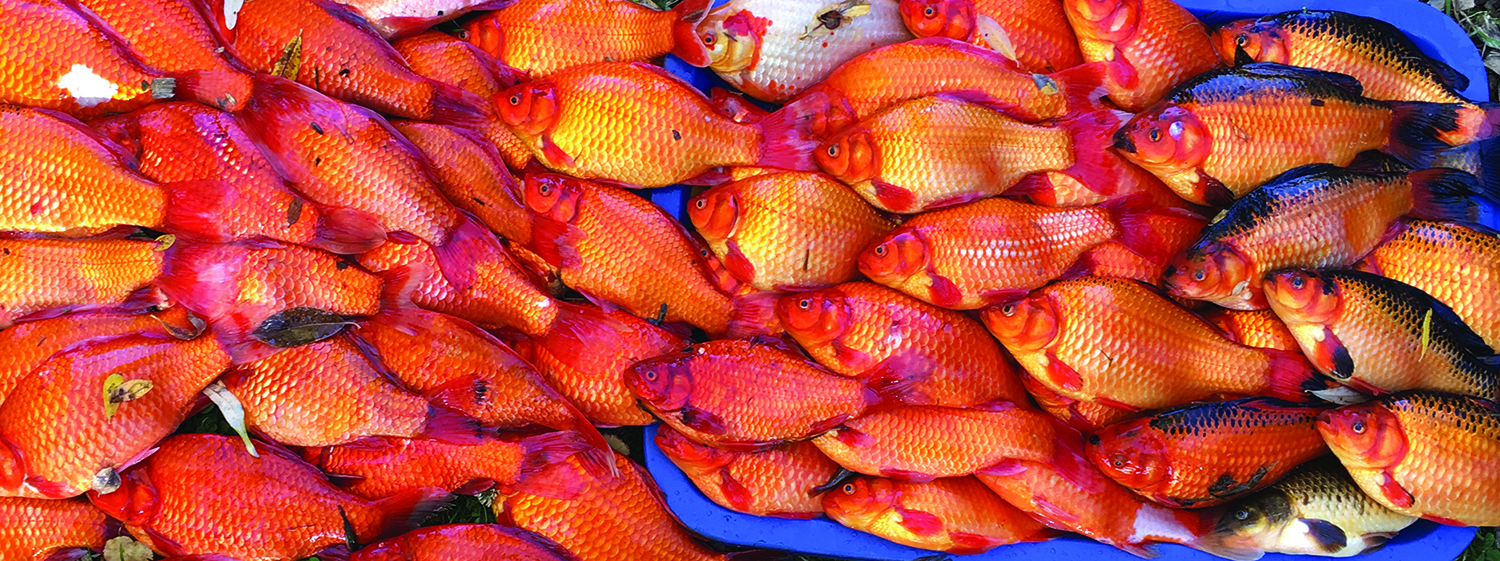
5 minute read
Canada wins gold! Alberta wins GOLDFISH?
by Paige Kuczmarski, AISC
photos: Alberta Environment and Protected Areas
After what we all thought was a sure thing, the recent IIHF World Juniors battle for gold was one for the books! The Canadian team fought hard and was able to take back the lead with a highlight reel overtime goal. The tale of a desperate back-and-forth battle is one of the oldest in the book, and one the Alberta Invasive Species Council (AISC) is far too familiar with. A feeling of hopelessness, that we can’t win, is a common sentiment whether playing hockey or dealing with invasive species.
Invasive species can be plants, animals or diseases that are not native to an area and cause harm, either environmentally, socially or economically. These invasive species are introduced through many means including intentional release and accidental transportation.
Intentional release continues to hinder our chances of defeating this daunting foe. It is no secret that invasive species have been making waves across North America—especially aquarium pets and plants, which can become invasive if released into the wild. We’ve seen some grueling face-offs, like the zebra mussel-contaminated moss balls distributed and sold in pet stores across North America in 2021.
Closer to home, Prussian carp was recently discovered north of Edmonton, hundreds of kilometres away from any other known location. Did you know that Alberta claims the first known introduction of Prussian carp in North America? Not a claim to fame that we are proud of though. But the one that takes gold would be none other than the most iconic aquarium pet: the goldfish. Currently, there are over 100 confirmed infestations of goldfish across Alberta as a result of intentional releases, all of which were 100 percent preventable.
Goldfish are a costly species to manage and a significant threat to aquatic ecosystems. In recent years, goldfish have routinely been released into stormwater management facilities and neighbourhood ponds. These ponds, which are designed to direct excess water into local waterways to prevent flooding houses, present a pathway for goldfish and other aquatic invasive species introductions. Controlling these invasive species in stormwater ponds is tricky, but when they enter natural waterbodies very few control options exist to manage their populations. Goldfish and other aquatic invasive species threaten native species by competing for food and habitat. There is also the threat of disease transmission from aquarium releases to native aquatic species.
With the number of goldfish infestations continuing to grow, the AISC is determined to spread awareness of preventing the release of aquarium pets and plants into the wild by supporting the nationwide “Don’t Let it Loose” campaign. The AISC works to engage and empower Albertans to prevent, detect, and take action against invasive species. The AISC received funding through an Alberta Conservation Association (ACA) Conservation, Community, and Education Grant in 2022 to promote the “Don’t Let it Loose” messaging and to encourage Albertans to C.A.R.E. (Contact, Act responsibly, Report and End ownership) about their aquarium species, rather than releasing them into our world-famous ecosystems.

The AISC engaged with aquarium enthusiasts and groups at virtual and in-person events, created a C.A.R.E. pledge to promote responsible aquarium species behaviour, and perhaps the most exciting was the development of a goldfish mascot—Tank, the MVP of the aquatic invasive species team! Tank made his formal debut on March 7 at the AISC Annual Conference at Olds College. Keep your eye open for Tank and the AISC team at other events throughout Alberta, where fans can meet and greet this awardwinning specimen.

We want you to C.A.R.E.
Start the wave of information to C.A.R.E. and prevent the release of aquatic invasive species!
C – CONTACT someone to adopt your pet or plant, use online classified ads, research humane societies or science centres, or contact the pet store you purchased it from to see if they’ll take it back.
A – ACT RESPONSIBLY by researching pets and plants before adopting and make sure you’re willing to commit to their lifetime of care. Know which species are legal to own, native to your region, and buy from reputable retailers. Ensure any water from aquariums, ponds, or water gardens is poured on land and away from drains, sewers, or other bodies of water.
R – REPORT any animals, pets or plants that may be of concern to the Aquatic Invasive Species Hotline at 1-855-336-BOAT(2628) or on the free EDDMapS reporting app.
E – END OWNERSHIP by contacting a qualified veterinarian to euthanize your pet. Bury it instead of flushing it down the toilet so it cannot spread diseases. Dry and freeze plants in a sealed bag before throwing them in the trash—do not compost!
To learn all the stats and infractions from these aquatic invasive species and the barnburner campaigns the AISC supports, check out their website at www. abinvasives.ca and DON’T LET IT LOOSE!











